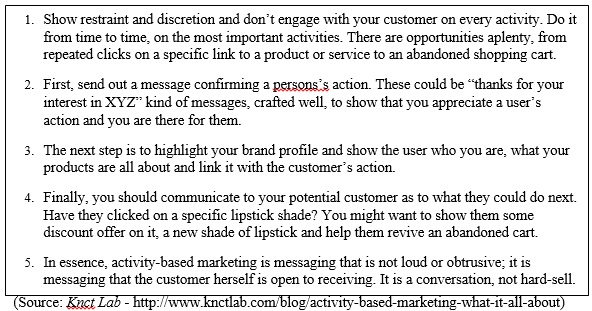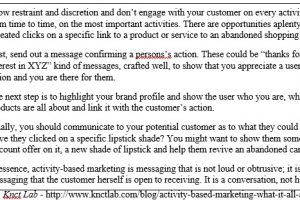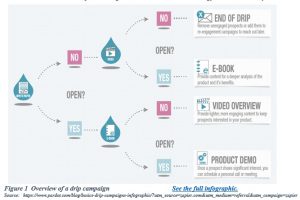Prof. S. Shyam Prasad PhD
Introduction
In the VUCA (Volatile, Uncertain, Complex and Ambiguous) world, hypercompetition[1] is the order of the day. To keep one self relevant, one has to keep abreast with the latest trends. Continuing in the direction of creating knowledge for the management students, this blog discusses Activity-based Marketing and Drip Marketing. Though the earlier blog on Account Based Marketing (ABM) and this write-up are independent of each other, it is in the interest of the reader to read both of them to appreciate the nuances of marketing in these activities.
Hypercompetition is rapid and dynamic competition characterized by unsustainable advantage created by rapid escalation of competitive tactics used among direct business competitors. It may include techniques such as pricing adjustments, increased marketing efforts and product improvements. Activity-based marketing (not to be confused with Account Based Marketing – ABM) and Drip Marketing are two such efforts to increase the efficiency and success rate of marketing efforts. Before we dwell on them any further, it is prudent to understand what they are.
Activity–based marketing is a communication strategy of delivering promotional messages on the basis of an observed activity by a potential customer, in real time. For example, sending an email to the person after observing that the person has visited the website.
Drip marketing is also a communication strategy and is known by different other names such as automated email campaign, lifecycle emails, auto responders and marketing automation. The idea is same for all these: marketing emails will be sent out automatically on a schedule.
Activity–based marketing
John Wanamaker (1838-1922) a very successful United States merchant, religious leader and political figure and considered by some to be a “pioneer in marketing” is credited with coining the phrase “Half the money I spend on advertising is wasted; the trouble is I don’t know which half” (Chait, 2015 ) . Till recently, one of the problems that marketers had was not knowing to who and when the right time was to deliver their messages. The traditional forms of delivering marketing communications such as — TV, radio, print, direct mail — are outbound in nature and after delivering the messages, the marketers pray for a good response.
Another type of delivering marketing communications that is fast gaining ground is Activity–based Marketing. As the name implies, activity-based marketing is based the activities of potential customers; promotional messages are automatically sent on identifying a user’s intent and building on it. There are many tools available to the marketer to automate messaging to the consumers. Leaving the technical part to IT specialists let us understand the key elements that define activity-based marketing.
[1] Hypercompetition is rapid and dynamic competition characterized by unsustainable advantage created by rapid escalation of competitive tactics used among direct business competitors. It may include techniques such as pricing adjustments, increased marketing efforts and product improvements.
Personalisation: The first element of activity-based marketing is that the messages can be personalised. Marketers can create specific landing pages with copy, offer announcements, forms and images that apply to the specific set of people that visit the page. Commonly, marketers use the name of the visitor to personalise the page. However, marketers have to remember that not every potential customer likes to be called by name and could find the exercise intrusive.
Retargeting: Another element of activity based marketing is retargeting. In this aspect, the marketer tries to constantly engage with a specific people. Typically this done when a person visits a commercial site and checks out a specific product or service but doesn’t buy it and drops it. In such a situation, retargeting is done. The marketer attempts to engage with that user elsewhere – say Facebook or Instagram – by sending ad for the product or service in which the user had shown interest earlier.
In activity-based marketing, with the help of cookies in the computer, marketers track the users’ visits and keep tag of what the user ordered last time and in some cases, even connect the user with other users to see what they like etc. An example for activity-based marketing may be say you’ve had your eye on a new shirt from a online retailer and add it to the cart. But after some deliberation, you decide not to buy it for now. The next day you notice an ad for that exact shirt pop up in your Facebook© newsfeed. Then you check your email and, coincidentally, that exact shirt is on sale! This is activity-based marketing.
Activity-based marketing is a kind of implicit permission marketing; the customer has evinced some interest in the product and may be ready and open to receive information. By sending the relevant mail or ad, the marketer is trying to close the sale by gently pushing the customer to take an action. This is not a cold calling.
Some tips for employing activity-based marketing:
Drip marketing
The phrase “drip marketing” is said to be derived from “drip irrigation”, an agriculture / gardening technique. Marketing automation company Pardot shows – Figure 1 – an overview of a drip campaign.
marketing. The major difference between activity-based marketing and drip marketing is the timing. Whereas the activity-based marketing is triggered by a customer’s activity, drip marketing starts blindly and depending on the recipient’s action further course of action is decided. Another difference is that the messages in drip marketing are sent in drips depending on the customer’s reaction to the earlier messages. Besides the starting point and small difference here and there they have much in common. The objective of both the strategies is same – to deliver ads at a time when one can expect them to have maximum impact. It isn’t spray and pray, it’s drip and grip
Since, drip marketing campaign can start blindly, it can used to generate and qualify leads. The new leads generated are automatically enrolled for leading them to action. This process is also known as lead nurturing. These messages though often takes the form of emails, any other media can also be used.
“Drip marketing” is a blanket term that covers several different marketing strategies. But the goal remains the same: keep users engaged with your product. (Stych, 2015)
10 cases where setting up drip campaign could help:
- Nurturing Leads
- Welcoming
- Onboarding
- Abandoned Shopping Carts
- Recommendations
- Renewals
- Confirmations
- Engagement
- Courses
- Unsubscribes
(Source: https://zapier.com/learn/email-marketing/drip-marketing-campaign/ )
Example of Drip Marketing: Below is an example of drip marketing.
No time is wasted in banal generalities. The customer is nudged to log in.
Conclusion
The information provided in this write-up is not exhaustive; the adage ‘tip of the iceberg’ is very appropriate here. It covers most of the crucial aspects of these two strategies and the students can continue learning more from this basic knowledge. Marketing is highly competitive and creative that new trends and marketing strategies keep evolving and the management students, particularly the marketing specialists should keep abreast with the latest developments in the market.
(Disclaimer – The views, opinions, and content on this blog are solely those of the author. ISME does not take responsibility for the content, which is plagiarized or not quoted.)
Works Cited
1. Becker, B. (2019, October 29). The Ultimate Guide to Account-Based Marketing (ABM). Retrieved 10 29, 2019, from hubspot.com: https://blog.hubspot.com/marketing/account-based-marketing-guide
2. Chait, G. (2015 , March 18). “Half the money I spend on advertising is wasted; the trouble is I don’t know which half.”. Retrieved from B2B Marketing: https://www.b2bmarketing.net/en-gb/resources/blog/half-money-i-spend-advertising-wasted-trouble-i-dont-know-which-half
3. Golden, M. (2018, September 26). What Is Account Based Marketing, Why You Should Adopt It, And How. Retrieved 10 30, 2019, from Linkedin Marketing Solutions Blog: https://business.linkedin.com/marketing-solutions/blog/linkedin-b2b-marketing/2016/what-is-account-based-marketing–10-definitions-from-the-experts
4. Kotler, P., Keller, K. L., Koshy, A., & Jha, M. (2013). Marketing Management (A South Asian Perspective) (14 ed.). New Delhi, India: Dorling Kindresley (India) Pvt. Ltd., licensees of Pearson Education in South Asia.
5. Stych, J. (2015, February 16). What is Drip Marketing? The Complete Guide to Drip Campaigns, Lifecycle Emails, and More. Retrieved December 12, 2019, from Zapier: https://zapier.com/learn/email-marketing/drip-marketing-campaign/
6. Unanimous. (n.d.).
7. Ward, S. (2017, August 16). How to Identify & Tier Target Accounts for Account-Based Marketing. Retrieved 10 30, 2019, from Terminus: https://terminus.com/blog/identify-tier-target-accounts-abm-marketing/
8. Wikipedia. (n.d.).







